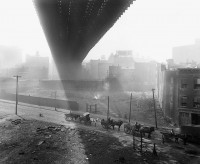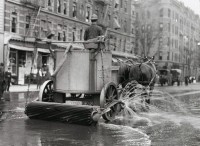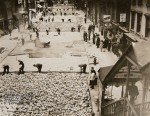 Last month, New York City’s Department of Records announced that it had digitized and uploaded 870,000 of the best photographs out of the 2,200,000 kept in the city’s Municipal Archives. The pictures date from the mid-1800s onward and document every aspect of city governance, from bridges to iconic buildings to mug shots to crime scenes to road work that captures vibrant immigrant neighborhoods as they were before gentrification flattened their characters. A few of them have been published before, but most of them are revelations.
Last month, New York City’s Department of Records announced that it had digitized and uploaded 870,000 of the best photographs out of the 2,200,000 kept in the city’s Municipal Archives. The pictures date from the mid-1800s onward and document every aspect of city governance, from bridges to iconic buildings to mug shots to crime scenes to road work that captures vibrant immigrant neighborhoods as they were before gentrification flattened their characters. A few of them have been published before, but most of them are revelations.
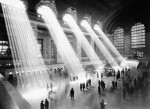 The Department of Records has been working for four years to make this vast store of hidden gems available to the public as part of an initiative to make city records generally accessible. Until now, if you wanted to see any of these pictures, you had to go to the archive building and go through the microfilm and print records. Although the entire archive hasn’t been uploaded at this point because it’s on a tight technological and funding budget, the department will continue to add new content to the online database.
The Department of Records has been working for four years to make this vast store of hidden gems available to the public as part of an initiative to make city records generally accessible. Until now, if you wanted to see any of these pictures, you had to go to the archive building and go through the microfilm and print records. Although the entire archive hasn’t been uploaded at this point because it’s on a tight technological and funding budget, the department will continue to add new content to the online database.
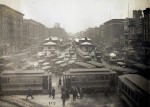 Those technological limitations became immediately obvious when the day after the database opened, it crashed. The interest was massive and came from all over the world, which meant that the poor server never caught a break.
Those technological limitations became immediately obvious when the day after the database opened, it crashed. The interest was massive and came from all over the world, which meant that the poor server never caught a break.
“There is so much world-wide interest,” said Eileen Flannelly, deputy commissioner for the city’s Department of Records. “We knew it would be huge in the city and for New Yorkers, but the actual interest coming in from Germany and Spain and Brazil and the Czech Republic, all of these places, they can’t get enough of it. Like 12,000 hits every few minutes in the middle of the night.”
It was down for weeks before they finally got their act together. Now the site is stable and therefore finally bloggable.
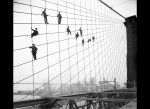 Most of the pictures were taken by anonymous municipal workers in the course of their duties, although there are some standout pieces by professionals like Eugene de Salignac, the Boston-born descendant of French nobility who at the age of 42 became the official photographer for the Department of Bridges/Plant and Structures in 1906. The department’s only photographer, over the next three decades he took 20,000 pictures of Manhattan’s most famous landmarks as they went up. He retired in 1934 and died in 1943, a virtual unknown, until in 1999 Municipal Archives photographer Michael Lorenzini recognized that a number of outstanding photographs had to be the work of one man. Lorenzini dug through the archives and historical records and finally put a name to the prodigious talent, bringing de Salignac out of obscurity into museum exhibits and coffee table books.
Most of the pictures were taken by anonymous municipal workers in the course of their duties, although there are some standout pieces by professionals like Eugene de Salignac, the Boston-born descendant of French nobility who at the age of 42 became the official photographer for the Department of Bridges/Plant and Structures in 1906. The department’s only photographer, over the next three decades he took 20,000 pictures of Manhattan’s most famous landmarks as they went up. He retired in 1934 and died in 1943, a virtual unknown, until in 1999 Municipal Archives photographer Michael Lorenzini recognized that a number of outstanding photographs had to be the work of one man. Lorenzini dug through the archives and historical records and finally put a name to the prodigious talent, bringing de Salignac out of obscurity into museum exhibits and coffee table books.
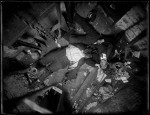 The database also includes a grimly fascinating collection of glass-plate photographs taken by the New York City Police Department. It’s the largest collection of criminal justice evidence in the English-speaking world, and it’s amazing how many of these grisly murder scenes are so artful they could easily be stills from a film noir.
The database also includes a grimly fascinating collection of glass-plate photographs taken by the New York City Police Department. It’s the largest collection of criminal justice evidence in the English-speaking world, and it’s amazing how many of these grisly murder scenes are so artful they could easily be stills from a film noir.
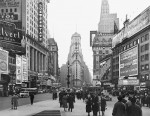 Less bloody but just as fascinating are the 1,279 images collected by the Works Progress Administration’s Federal Writers’ Project, a New Deal program that between 1935 and 1943 collected pictures from Art Project photographers and others for inclusion in publications like the WPA Guide to New York City. When the program ended, the Municipal Archives acquired the collection.
Less bloody but just as fascinating are the 1,279 images collected by the Works Progress Administration’s Federal Writers’ Project, a New Deal program that between 1935 and 1943 collected pictures from Art Project photographers and others for inclusion in publications like the WPA Guide to New York City. When the program ended, the Municipal Archives acquired the collection.
You can search the database by keyword or department, or you can browse by categories. I prefer the categories because I like going through the pictures from oldest to newest.
